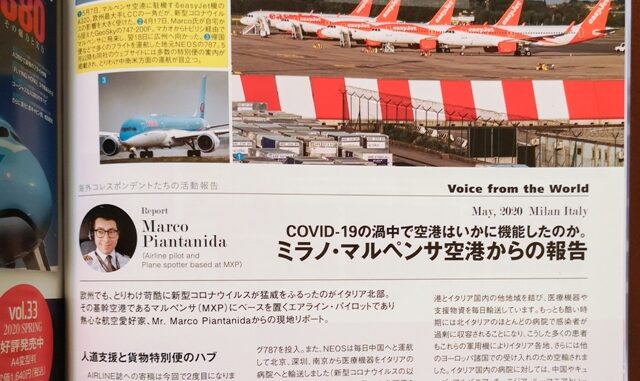
MALPENSA – L’impatto del nuovo Coronavirus nel trasporto aereo del Nord Italia. Si intitola così l’articolo che Airline, rivista giapponese di settore, ha dedicato a Malpensa e alla grande crisi causata dall’emergenza sanitaria.

Malpensa in Giappone
 L’articolo porta la firma di Marco Piantanida che per la seconda volta collabora con la rivista giapponese, interessata a quanto accade in Italia e in particolare nell’aeroporto intercontinentale di Milano, dove lui è di casa.
L’articolo porta la firma di Marco Piantanida che per la seconda volta collabora con la rivista giapponese, interessata a quanto accade in Italia e in particolare nell’aeroporto intercontinentale di Milano, dove lui è di casa.
Piantanida infatti, classe 1994 e sommese di nascita, non soltanto è pilota per una nota compagnia aerea (con la qualifica di First Officer sul Boeing 737NG) basata a Malpensa, ma nel suo tempo libero coltiva la passione per la fotografia. Gli aerei sono naturalmente i suoi soggetti preferiti, come dimostrano i bellissimi scatti che pubblica giornalmente sulla sua pagina Instagram @marcopiantanidaphotography.
Durante il mese di aprile, in pieno lockdown, è stato contattato da Ryo Yamada, editore della rivista aeronautica giapponese Airline per scrivere un breve reportage sull’impatto del Covid a Malpensa.
Il Covid a Malpensa
Di seguito l’articolo di Piantanida pubblicato in Giappone nella sua traduzione in inglese:
It is the second time I am honored to write for AIRLINE magazine, with humble effort I will try to report a wide view about the current situation that commercial air transport is facing in northern Italy, due to the impact of the New Coronavirus, with a spotlight on Milan Malpensa Airport.
There were big plans for 2020 at Malpensa airport, with lots of new routes especially with Eva Air to Taipei operated by the B777-300ER and with ANA and its B787-9 to Tokyo Haneda, that was going to start on last April.
While this new virus has been spreading around the World since the beginning of the year, we have seen a large fall of passenger demand upon government travel bans have been enforced last march. Northern Italy was one of the areas in Europe were the virus had the first big impact. The Italian government ordered for an almost total two months lockdown trying to stop the virus from spreading along the country. Most of the airlines had to cancel a lot of their flights and subsequently decided to ground most of their airplanes.
ENAC, which is the Italian aviation authority, closed the majority of the secondary airports in Italy and Milan Malpensa became the biggest hub for humanitarian and cargo flights for Northern Italy, despite the main Terminal 1 was temporary closed.
Over the last months a lot of airlines operated humanitarian flights to bring back to their countries people that were blocked in Italy for the lockdown or to repatriate Italians around the World. Neos Air, an italian charter company based in Milan, operated many of these flights with its 4 Boeing 787 Dreamliner, especially to the Americas and Asia. The same company is operating to China every day, with flights to Beijing, Shenzen and Naijing airports, carrying medical equipment to the Italian hospitals.
Neos is not new to chinese destinations. Before the coronavirus crisis, the company had already weekly scheduled flights to three destinations (Nanjing, Guiyang and Nanchang).
Despite air travels has been affected by a deep crisis worst than 9/11, we cannot say the same about cargo air transport. In the past weeks there has been an increased payload and number of special flights in this sector. Cargolux Italia (subsidiary of Cargolux) and Volga Dnepr increased the number of frequencies to China and Hong Kong. A special flight from China with fuel stop in Tblisi was operated by GeoSky with an iconic B747-200F with RR engines (reg. 4L-GEN ex. British Airways). This type of airplane was missing from Milan since 2016, when Kalitta Air brought one of its old -200F, now not longer in use.
Many of these special flights were also operated by passenger airplanes loaded with boxes on their seats. The majority of these flights have been performed (excluding Neos) by foreign airlines like China Eastern, Juneyao Airlines, Air China.
Talking about the national scenery, Italian Army is using its Hercules C-130, C-27J Spartan and ATR72MP (special military version) on a daily basis delivering medical equipment and support between Milan and the other Italian regions. During the worst days of this humanitarian crisis, when most of the hospitals of northern Italy were completely overloaded with Covid19-patients, the same airplanes were used to move a number of these people to other regions and European countries. A great solidarity act has been shown also from some countries like China, Cuba, Albania, Tunisia and Romania sending not only medical equipment but also doctors and nurses to the Italian hospitals.
Along these months the airport has been used to store airplanes from many airlines. Malpensa is the second biggest Easyjet base after London Gatwick. In normal operations the airport hosts 23 orange and white Airbus but now, in order to minimize costs over the network, most of the airplanes have been relocated, reaching almost 40 units at MXP Airport.
The best hope is that after this humanitarian-economical crisis the traffic at Milan Malpensa Airport will come back to 2019 levels in few years, but aviation and air travel in general will change, seeing less 4-engine jets in the sky, opening the way to new fuel efficient and more economical Boeing 777X and Airbus A350 XWB jets, for the sadness of many “old fashioned” spotters.
A Malpensa arrivano i giapponesi. All Nippon Airways vola su Tokyo Haneda


